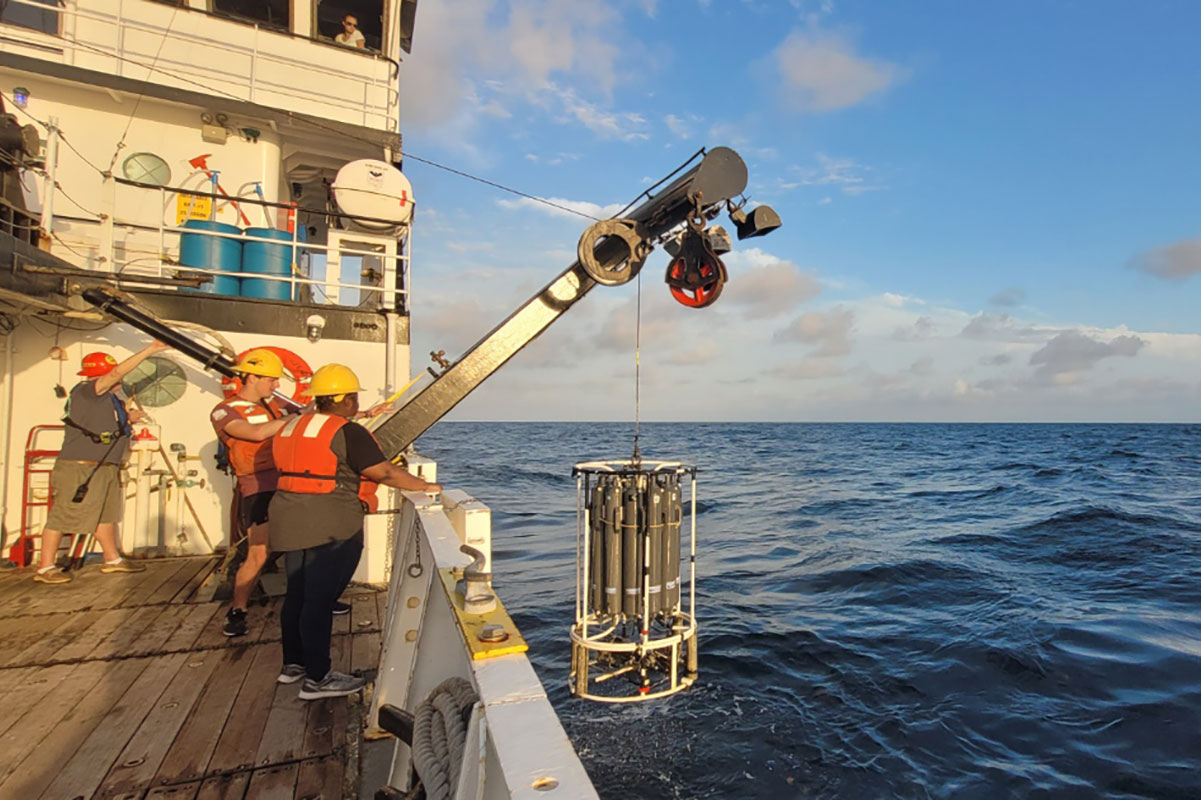
Multi-day, at-sea research experiences are uncommon opportunities for undergraduate students. Thanks to the generosity of Col. Hal C. Schade ’67, Texas A&M University oceanography undergraduates gain such critical hands-on experiences every summer, courtesy of a Gulf of Mexico research cruise.
The most recent Schade Cruise sailed May 23–27, adding an additional day to last year’s four-day itinerary to allow for a sampling route further offshore and into deeper waters. Led by Chrissy Wiederwohl, instructional associate professor in the Department of Oceanography at Texas A&M, and Shari Yvon-Lewis, oceanography professor and department head, a group of 12 students sailed aboard the R/V Point Sur.
The annual cruise is graciously supported by a gift from Schade, who has visited campus each year since the inception of the cruise to wish the students bon voyage.
“We can't thank Hal enough for his generous gifts that have allowed our students to grow into competent and confident oceanographers,” Yvon-Lewis said. “It is always exciting to see the growth in each student over the course of the research cruise.”
Schade is passionate about the ocean and helping Aggies find meaningful careers in ocean sciences. After graduating from Texas A&M in 1967 with a journalism degree, he served 12 years of active duty in the U.S. Army, retired with 28 years in the Army Reserves, and went on to work in journalism and public relations. From 2003–2009 he sailed the Western Caribbean on his boat, Griffin, and then returned to College Station and renewed his involvement with and support of Texas A&M, which also includes gifts toward the College of Arts and Sciences Leadership Scholars Program and the annual Texas A&M Physics and Engineering Festival.
Today, his giving makes the Schade Cruise possible, providing undergraduate students with the enhanced education and hands-on experiences necessary to fully grasp oceanographic research.
One goal of the Schade Cruise is to build a multi-year dataset to monitor Gulf of Mexico oceanographic conditions. Continuing some of the previous years’ work, this year’s cruise conducted full water column profiles, including sampling for oxygen, dissolved inorganic carbon, nutrients, and salinity, among many other measurements. The longer route also afforded the opportunity to add more sampling stations in waters more than 8,200 feet deep.
Wiederwohl notes that students are not mere observers on the Schade Cruise, but full participants in all aspects of the science. Each is assigned a 12-hour shift and various responsibilities throughout the trip.
“What makes these cruises so rewarding is seeing the students grow in their scientific roles in such a short period of time,” Wiederwohl said. “They go from being hesitant to touch equipment for fear of breaking something, to a newfound confidence in their own scientific capabilities.”
Wiederwohl says that surface drifters, which are GPS-enabled buoys that move with the currents, were a new tool in their arsenal this year. The students deployed the drifters to track currents by GPS, providing important ocean data to the National Oceanic and Atmospheric Administration’s (NOAA) Global Drifter Program. The buoys allow for real-time ocean observations that contribute to NOAA’s Global Ocean Observing System.
“My specific duties on the cruise were in the marine tech’s room, and I basically controlled and watched the monitors as we lowered and raised the CTD rosette, which is this massive seven-foot device [used for collecting water samples and data at sea],” said Jocelyn Morales, a senior oceanography major from Houston. “I also worked closely with my professor, Dr. Yvon-Lewis, when determining what depths were appropriate for firing our niskin bottles, from which we obtain different samples.”
This year was Morales’ first Schade Cruise experience. She was assigned to the night shift, which is midnight to noon, where she also worked within a team collecting various samples, including oxygen, fluorescence and salinity. She also collected per- and polyfluoroalkyl substance (PFAS) samples at some of the deepest stations.
“Having this role on the Point Sur really helped me connect the dots with my knowledge from my courses,” Morales said. “I have never done something so demanding before when it comes to oceanography, and this experience helped me realize that I am capable of accomplishing more than I think I can.”
For most, this was their first time on the Schade Cruise, but a few were returning for their second year, including senior oceanography major and Del Rio, Texas, native Norely Faz ’23. From her first cruise to her second, she says both her responsibilities and her confidence increased.
“I think my duties were assigned in a perfect order,” Faz said. “The first year taught me how scientists work together, and the second gave me more responsibility and encouraged growth in my sampling skills.
“The food was great, the weather was beautiful and the people were amazing. I have met most of my best friends on these cruises. The short but strong bond that forms on a vessel when none of you really know what you’re doing to begin with is amazing.”
Along with hands-on experience, the cruise offers the chance for students to get closer, in-depth instruction from their professors and even learn directly from the crew of the R/V Point Sur.
“The vessel crew is also a really important part for any cruise,” Faz said. “Our crew made it so that we always felt welcome to ask any questions or make requests.”
“We can’t thank the crew of the Point Sur enough for their patience and willingness to work with the students as they learn science at sea,” Wiederwohl said. “It really is the perfect research vessel for these cruises.”
Learn more about funding high-impact experiences and enhancing student opportunities in the College of Arts and Sciences.
